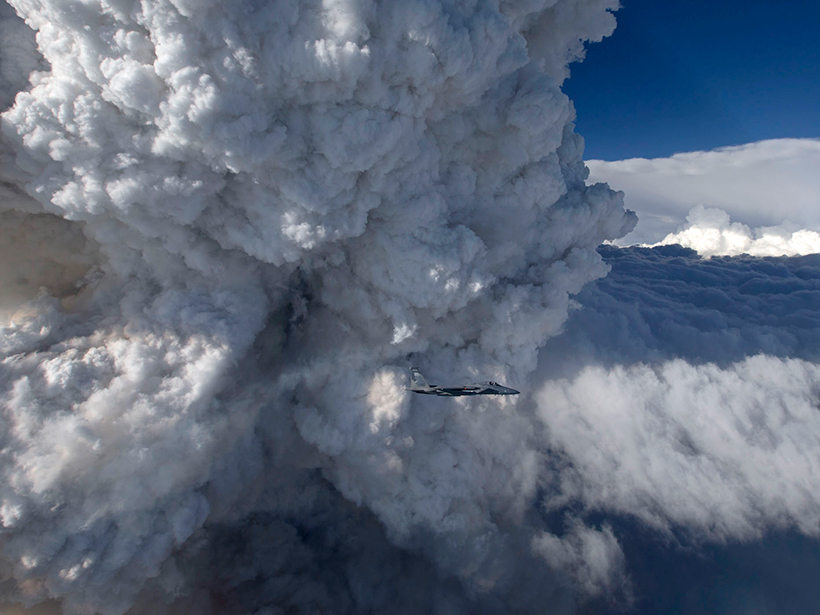There is a place high in our atmosphere that is so dry and has such little water vapor that there’s rarely a cloud in sight. When smoke from a wildfire, volcano, or nuclear explosion ends up in this layer of the atmosphere, it can stay there for months.
Scientists worry that smoke resulting from nuclear warfare could become stuck in the high reaches of the atmosphere, bringing about nuclear winter and global famine. But very few real-life examples of smoke reaching the stratosphere have occurred since modern sensors began tracking the environment, making it difficult for scientists to ground truth their predictions.
The latest study “should give further impetus to warn the world that nuclear weapons can never be used.”
A study published 8 August in Science used observations from wildfire smoke in Canada in 2017 to test atmospheric models used for nuclear winter simulations. The study verified scientists’ understanding of smoke “self-lofting” into the stratosphere and gave them insights into how long smoke could remain adrift. The findings were published during the same week as the 74th anniversary of the atomic bomb that was dropped on Hiroshima, Japan.
“What we saw actually validated our previous calculations and gives us more confidence that they are correct,” Alan Robock, an author on the paper and a professor at Rutgers University in New Jersey, told Eos. Even if countries use just 1% of the globe’s nuclear stockpile, Robock said that the resulting climate change could bring about a global food crisis. “It would be this horrible catastrophe for the world,” he added. The latest study, he noted, “should give further impetus to warn the world that nuclear weapons can never be used.”
“Nature Doing an Experiment”
Smoke contains minute pieces of partially burned organic material, called black carbon, that can propel air high into the atmosphere. Black carbon readily absorbs light, and when the tiny particles heat up, they warm the surrounding air, making it rise. There’s even a special name for clouds formed from smoke: pyrocumulus. In the case of the Canadian wildfire smoke, the fires gave off so much smoke it self-lofted 23 kilometers into the atmosphere, forming the largest pyrocumulus cloud ever observed.
The researchers compared their numerical simulations with data taken from the International Space Station and the joint NASA–Centre National d’Études Spatiales satellite Cloud-Aerosol Lidar and Infrared Pathfinder Satellite Observation (CALIPSO). The team also considered measurements taken by two weather balloons released several months after the fires and the following year, respectively.
The scientists then seeded their climate models with smoke and watched as atmospheric processes transported it. Using a certain amount of black carbon for the Canadian wildfire smoke, they found that the simulations served as a close match to reality.

The research team also learned that ozone in the stratosphere degrades smoke and that climate models must take this into account to accurately predict how long smoke will stay airborne.
“This is nature doing an experiment for us on a small scale and allows us to test our theory,” Robock explained. In this case, he said, the model “validates our calculations that we’ve done before.”
Professor Georgiy Stenchikov at King Abdullah University of Science and Technology in Saudi Arabia, who did not participate in the research, told Eos that the findings not only present experimental evidence of smoke lofting into the stratosphere but also show that modern climate models are up to the task of effectively modeling smoke transport.
Scientist Mike Mills at the National Center for Atmospheric Research in Boulder, Colo., said that the latest study also “provides crucial validation” for nuclear winter theory. Mills is unaffiliated with the paper.
“This study demonstrates for the first time that the models that predict devastating global impacts from a regional nuclear war are accurate,” Mills noted.
The Future of Nuclear Weapons
Robock expressed hope that the latest scientific findings can drive policy.
Humans have 13,850 nuclear warheads, according to the nonprofit organization Ploughshares Fund. The United States and Russia own over 90% of the stockpile.
In 2017, the United Nations adopted a treaty prohibiting the use of nuclear weapons. Since the unveiling, 25 states have signed on. Neither the United States nor Russia has joined the treaty.
“In the 1980s, when Soviet and American scientists got the same results, that there would be nuclear winter, they told [Ronald] Reagan and [Mikhail] Gorbachev,” Robock said. “That helped lead to the end of the nuclear arms race.”
“I hope we can do that again,” Robock added.
—Jenessa Duncombe (@jrdscience), News Writing and Production Fellow
14 August 2019: The story has been updated to reflect the impact of nuclear warfare on climate.
Citation:
Duncombe, J. (2019), What wildfire smoke tells us about nuclear winter, Eos, 100, https://doi.org/10.1029/2019EO130789. Published on 08 August 2019.
Text © 2019. AGU. CC BY-NC-ND 3.0
Except where otherwise noted, images are subject to copyright. Any reuse without express permission from the copyright owner is prohibited.
Text © 2019. AGU. CC BY-NC-ND 3.0
Except where otherwise noted, images are subject to copyright. Any reuse without express permission from the copyright owner is prohibited.

